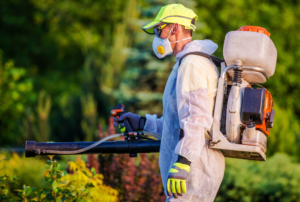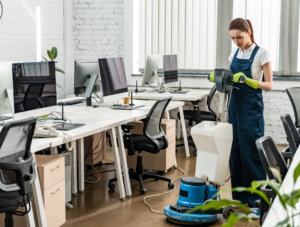Most pests get a bad rap, but they are important to our ecosystem. For example, ladybugs help eat aphids that would otherwise destroy our prize roses. Contact Bakersfield Exterminator now!
Spraying overkill pesticides may decrease the number of bugs temporarily, but these insects develop resistance to these chemicals over time. A professional exterminator can help prevent problems by addressing the root causes and implementing exclusion strategies.

While there are some pests that can be handled by home and garden owners, others require the expertise of professional exterminators. These specialists eradicate insects and rodents in homes and businesses, using various chemicals and natural solutions. Their services also include trapping and sealing entry points to prevent infestations from recurring. Some exterminators specialize in specific types of pests, such as cockroaches or mice, while others have broad knowledge and experience in dealing with a wide range of infestations.
In addition to removing pests, exterminators can also advise on best practices for keeping them at bay. This can include landscaping tactics, cleaning strategies, and vigilant monitoring for signs of infestation. While these methods are not foolproof, they can provide significant reduction in pest populations, especially when coupled with a comprehensive treatment plan.
For many homeowners, an ounce of prevention is worth a pound of cure. This is why it’s important to have your property inspected by an exterminator on a regular basis. Whether you’re looking to buy or sell a property, a preventative inspection could save you from the headache of dealing with an insect or rodent infestation in the future.
A residential exterminator can offer a variety of services, including sealing entry points to address pest prevention, trapping and exterminating pests that have already infiltrated a building, and using organic or green methods for treating large infestations. They can also recommend pest-prevention measures to help you avoid an infestation in the future, such as sealing cracks or installing caulking, keeping garbage and compost bins securely closed, and ensuring that any indoor space is adequately ventilated.
Unlike some DIY solutions, a licensed and reputable exterminator can handle any type of pest problem with the highest level of safety and effectiveness. With a background in chemistry and physics, an exterminator is trained to know what solutions are most effective for each situation. In addition, they have access to state-of-the-art equipment and a range of high-quality chemicals.
Commercial
Pests can cause significant damage to your business. They can destroy inventory, contaminate food, and even damage your property. They can also spread serious diseases to your employees and customers. That is why it’s important to have a professional exterminator handle your commercial pest control needs as soon as possible.
The cost of a pest control service can vary greatly depending on the size of your property and the type of infestation. Some services may require more frequent visits, and you will need to consider additional costs such as ongoing monitoring and emergency call-outs. However, you can often find affordable commercial pest control options that will suit your needs.
When choosing a pest control company, look for one that uses environmentally friendly methods and treatment equipment. For example, you should be able to find companies that use natural pesticides such as pyrethrins or pyrethroids. These chemicals are similar to those found in some chrysanthemums and are less harmful to the environment than their synthetic counterparts. You should also check the company’s reputation and reviews to ensure they are a reputable service provider.
In addition to treating pests, a good commercial pest control company should also offer preventative services. These services can help you avoid future infestations and keep your business running smoothly. They can also save you a lot of money in the long run, as pests can cause costly damage to your property.
Pest control is an essential part of any business. Without it, you could lose revenue and even your reputation. A professional pest control service can help you keep your customers and employees safe, and they can also help you stay compliant with industry regulations. If you’re worried about the safety of your business, contact a reputable pest control company in NYC or Long Island. They will develop a custom pest control plan that will meet your specific needs and keep you pest-free.
Industrial
Exterminators work in a variety of settings, including residential, commercial, and industrial. They use a variety of methods to control pests, such as chemical treatments, traps, and baits. They may also employ exclusion techniques to prevent pests from re-entering the property. Some exterminators also specialize in specific types of pests, such as bed bugs or cockroaches.
Pest problems can be a real nuisance for businesses and their customers. They can cause costly damages and even health risks. That’s why it’s important to enlist the services of an experienced exterminator.
Commercial pest exterminators deal with a wide range of business establishments, such as restaurants, hotels, and hospitals. These specialists work with business owners to develop a pest management plan that’s tailored to the needs of each company. They’re also familiar with the regulations and best practices for pest management in different industries.
An exterminator’s job starts with a thorough inspection of the premises. During this process, they’ll identify the type and extent of the pest infestation. They’ll also determine if there are any environmental issues that could contribute to the problem. Once they’ve completed the inspection, they’ll recommend a treatment plan. This may include extermination or non-extermination methods, depending on the severity of the infestation.
For small infestations, exterminators often recommend non-chemical prevention methods. These include sealing cracks, draining standing water, and removing debris from the exterior of the building. For larger infestations, they’ll recommend more intensive extermination methods. In some cases, an exterminator may recommend integrated pest management (IPM), which is a systemic approach to pest prevention that minimizes the use of pesticide chemicals.
In warehouses and other industrial settings, a more hands-on approach is needed to keep pests away from products and equipment. A pest infestation can quickly lead to failed inspections and shutdowns. To avoid this, it’s crucial to hire an experienced exterminator that specializes in warehouse pest control.
Warehouse
Warehouses are the perfect playground for pests because they have plenty of open entrances and areas to hide. Rodents such as mice and rats are common warehouse pests. Their droppings and urine contaminate products, posing health risks for employees and consumers. These pests also gnaw and chew through items, causing damage and financial losses. Infestations of warehouses can quickly become out of hand if not promptly addressed.
Warehouse pest control is critical for the safety of stored goods and the efficiency of facility operations. Infestations of warehouses can quickly lead to contaminated or adulterated goods, resulting in customer complaints, load rejections, and costly recalls. In addition, pests can create an unhealthy and unsafe work environment for employees and cause product loss and damage to inventory.
A comprehensive pest control plan for warehouses includes preventive strategies and methods to monitor for signs of infestation. This is especially important in warehouses that store food-related products, as food contamination is dangerous to consumer safety. These prevention strategies include:
It is crucial to make sure that all warehouse spaces are properly ventilated and that entry points are not open or unprotected. These measures can be as simple as ensuring that all doors and windows close securely and that there are no cracks in walls or doors. It is also important to keep warehouse spaces clean and organized to discourage rodents from nesting.
Another important measure is to seal all entry points into warehouses to stop pests from getting inside and causing problems. This is particularly true for warehouses that use wood pallets and other wooden materials in the building. These warehouses are highly susceptible to termite infestations, which can be a serious problem for the structure of the building and the raw materials in it.
The best way to prevent a warehouse infestation is to have regular inspections and monitoring, along with good warehouse hygiene practices. Infestations can be prevented by making sure that all entry points are sealed, warehouses and storage areas are regularly cleaned, and that spilled food or organic waste is not left on surfaces for long periods of time. In addition, warehouses should have a proper waste management system in place to ensure that they do not attract pests with discarded food and other garbage.







